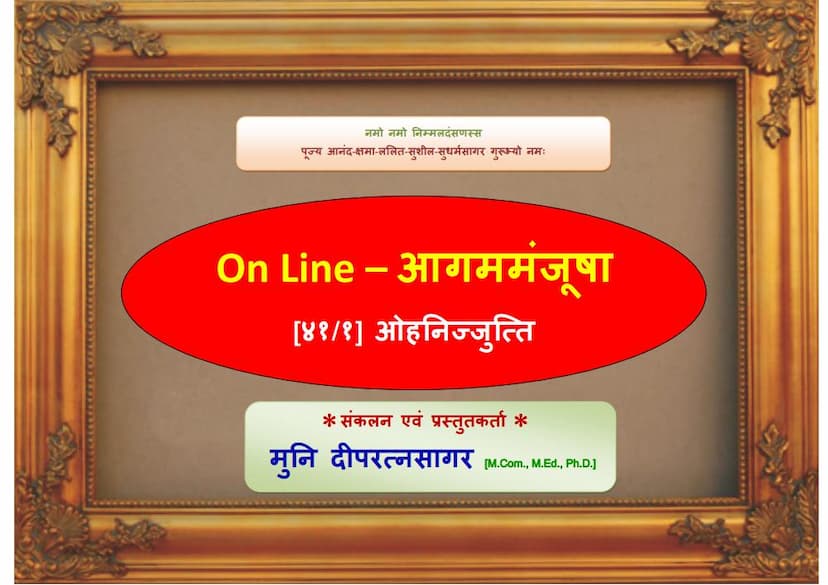Aagam Manjusha 41A Mulsuttam Mool 02 A OhNijjutti
Added to library: September 1, 2025

Summary
This document is a Jain text titled "Aagam Manjusha 41A Mulsuttam Mool 02 A OhNijjutti," authored by Anandsagarsuri and Sagaranandsuri, and published by Deepratnasagar. It is presented as part of the "On Line-Aagam Manjusha" project by Muni Deepratnasagar.
Key aspects of the text, based on the provided pages, include:
- Historical Context: The preface mentions that the original "Aagam Manjusha" was compiled approximately 70 years prior (around 1942 CE). The current online version, published in 2012, aims to present the same material with some useful modifications.
- Modifications in the Online Version:
- It includes not just the original Sutras but also their "Nijjutti" (commentary/interpretation) for "Aavashyak Sutra" (Agam-40) and "Jeetkalp Sutra" (Agam-38).
- For "Jeetkalp Sutra" (Agam-38), the "Panchkalp" commentary is also included.
- For "Ohniyutti" (Agam-41), the alternative Agam "Pindniyutti" is included, though its printing location might have changed.
- "Kalp (Barsa) Sutra" has also been included.
- Content of the "Ohniyutti":
- The text begins with a devotional invocation (Namo Arihantanam, Namo Siddhanam, etc.) and the auspicious "Pancha Namaskara Mantra."
- It delves into the concept of "Samaayachari" (proper conduct) and its various classifications, including "Ogha" and "Pinda."
- The core of the text appears to be a detailed explanation and commentary on the principles and practices related to Jain monastic life and conduct. This is evident from the extensive use of Prakrit and Apabhramsha language, interspersed with Sanskrit scholarly terms and explanations.
- Key Themes and Concepts Discussed:
- Anuoga (Categories of Study): The text refers to the four Anuogas: Charana (conduct), Karana (actions), Dharma (righteousness), Gana (monastic order), Dravya (substance), and Adravya (non-substance). It emphasizes the importance of Charana and its protective aspects.
- Conduct and Actions: It elaborates on various aspects of monastic conduct, including Samiti (restraint), Bhavana (meditation/contemplation), Pratima (vows/stages), and specific actions like 'Anukampa' (compassion).
- Types of Conduct: The text discusses different types of conduct, such as those related to the body, speech, and mind, and how they relate to the path of liberation.
- Purity and Defilement: There is a strong emphasis on maintaining purity in actions, thoughts, and possessions, and avoiding defilements.
- Prohibited Actions and Objects: The text details numerous rules and guidelines regarding what monks should avoid, such as certain types of food, objects, places, and interactions.
- Daily Life and Practices: It describes the daily routines and practices of monks, including begging for alms (bhiksha), inspection of utensils and bedding ("Pratilekhana"), and the proper way to conduct oneself in various situations.
- Types of Monks and Their Conduct: The text seems to differentiate between different types of monks (e.g., older, middle-aged, young, and those with different levels of understanding) and outlines specific guidelines for each.
- Compassion and Assistance: The text stresses the importance of compassion towards the sick and needy, and the proper procedures for providing assistance.
- Vows and Restraints: Various vows and restraints are discussed, highlighting the meticulousness required in their observance.
- Ethical Considerations: The text underscores the significance of ethical behavior, avoiding harm to living beings (Jiva Himsa), and maintaining proper conduct in social interactions.
- Scriptural Interpretation: The "Nijjutti" aspect suggests a deep dive into the scriptural meaning and practical application of the Sutras.
- Reasons for Rules: The text often explains the rationale behind specific rules, linking them to the ultimate goal of spiritual purification and liberation.
- Language: The text is primarily written in a form of Old Gujarati or Apabhramsha, with interspersed Sanskrit terms and grammatical structures, reflecting its ancient origins.
Overall, "Ohniyutti" appears to be a foundational text within Jain monastic literature, offering a comprehensive guide to the ethical conduct, spiritual discipline, and practical rules that govern the lives of ascetics in their pursuit of liberation. It emphasizes meticulous attention to detail in all aspects of life, aiming to minimize harm and maximize spiritual merit. The online presentation by Muni Deepratnasagar makes this important text accessible to a wider audience interested in Jainism.